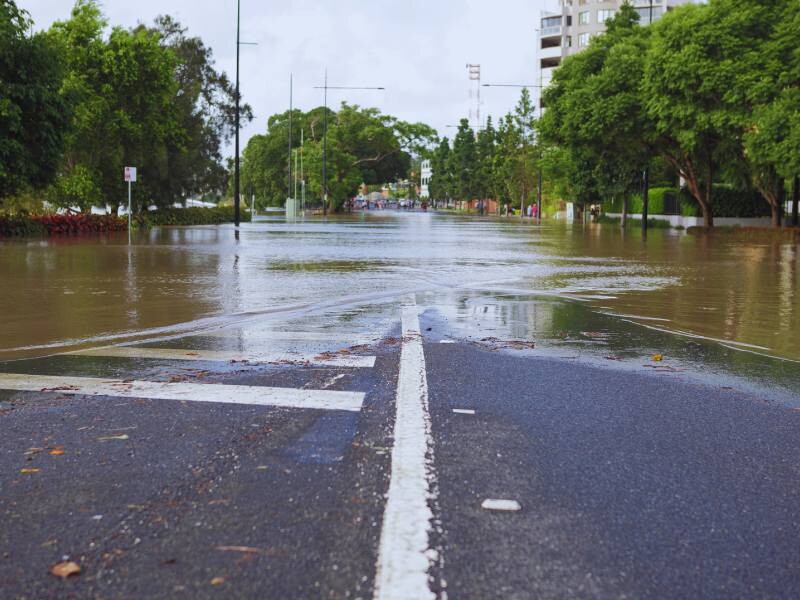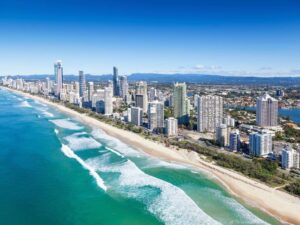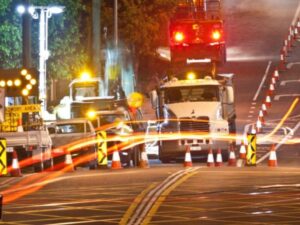Introduction
The wet season has arrived across South East Queensland and Northern New South Wales, bringing torrential rain, waterlogged roads, and an increased risk of flooding. With regions like Brisbane, the Sunshine Coast, Gold Coast, Toowoomba, and Northern Rivers already seeing significant rainfall, it’s essential for all road users to understand the dangers of driving in flood-prone areas.
At East Coast Traffic Control, safety is at the heart of everything we do. This blog highlights the critical importance of flood safety on our roads, offering practical advice to help you navigate the wet season and avoid unnecessary risks.
Why Driving Through Floodwaters Is Never Safe
Queensland’s government campaign, If It’s Flooded, Forget It, isn’t just a catchy slogan—it’s a life-saving warning. Floodwater, no matter how shallow it seems, can turn a routine drive into a life-threatening situation.
The Dangers of Floodwater:
- Zero Traction Control
Even just 15cm of water can cause your car to lose traction and become uncontrollable. Vehicles, regardless of their size, can be swept away by fast-moving floodwaters. - Power Steering and Engine Failure
Floodwaters can instantly disable your car’s steering, engine, and electrics, leaving you stranded. - Pressure-Sealed Doors and Windows
Once a vehicle is submerged, the external water pressure can make it impossible to open doors or windows, trapping passengers inside. - Unpredictable Roads
Flooded areas can conceal damaged infrastructure, such as washed-out bridges or potholes, turning familiar roads into dangerous traps.
Regional Flood Risks: Stay Vigilant in Our Key Areas
South East Queensland
Heavy rainfall often leads to flash flooding in areas like Brisbane, the Gold Coast, and the Sunshine Coast. Coastal roads and highways can be particularly treacherous, so always plan your journey during the wet season.
Toowoomba and the Darling Downs
Toowoomba’s elevated terrain may seem safer, but heavy downpours can create dangerous conditions on its sloping streets. Rural roads across the Darling Downs can quickly become impassable during rainstorms.
Northern New South Wales
The Northern Rivers region is no stranger to severe flooding. With recent rains, major thoroughfares in towns like Lismore and Ballina may face closures—always check road conditions before travelling.
Practical Tips for Driving During the Wet Season
1. Plan Ahead
- Use tools like Queensland’s live traffic updates and flood mapping tools to monitor conditions.
- Avoid unnecessary travel in areas where heavy rain is forecasted.
2. Know the “15cm Rule”
- As little as 15cm of water can disable your car. Never assume your vehicle can handle floodwaters, even if you drive a 4WD or truck.
3. Pack a Vehicle Flood Safety Kit
Include essentials such as:
- Flashlights with spare batteries
- High-visibility vests
- Emergency contact numbers
- Non-perishable snacks and water
4. Stay Alert for Road Closures
- Trust official signage and roadblocks put in place by traffic control professionals.
- If a road is closed, find an alternate route—don’t risk your safety.
5. Communicate Your Plans
Let someone know your travel route and expected arrival time, especially if you’re travelling through flood-prone areas.
How East Coast Traffic Control Keeps Roads Safe
During extreme weather events, East Coast Traffic Control provides expert traffic management to ensure the safety of road users. Our teams are well-versed in setting up emergency detours, placing signage, and coordinating with local authorities to mitigate risks in areas like Rockhampton, Mackay, and Townsville.
By focusing on proactive measures, we play a key role in minimising accidents and ensuring smoother commutes during the wet season.
Resources for Road Safety
Stay informed with these trusted sources:
- Queensland Government: If It’s Flooded, Forget It
- Live traffic updates via the Department of Transport and Main Roads
- Emergency contact numbers for regional councils
Conclusion: Safety First, Always
As we brace for the challenges of the wet season, remember that no destination is worth risking your life. If you encounter floodwaters, turn around—don’t attempt to cross. At East Coast Traffic Control, we’re committed to keeping our communities safe, whether by guiding traffic during emergencies or sharing essential road safety tips.
Let’s work together to ensure a safer wet season across Queensland and New South Wales.
FAQs
- How much water does it take to wash away a car?
As little as 15cm of fast-moving water can cause a car to lose traction and be swept away. - What should I do if I encounter a flooded road?
Turn around and find an alternate route. Never attempt to drive through floodwater. - What tools can I use to check road conditions?
Use live traffic updates from the Department of Transport and Main Roads or local council websites. - How does East Coast Traffic Control help during floods?
Our teams provide critical traffic management services, including emergency detours, road signage, and coordination with authorities to ensure safety. - What areas in Queensland and NSW are most at risk during the wet season?
Regions like the Sunshine Coast, Brisbane, Toowoomba, and Northern Rivers often experience significant flooding during heavy rains.





